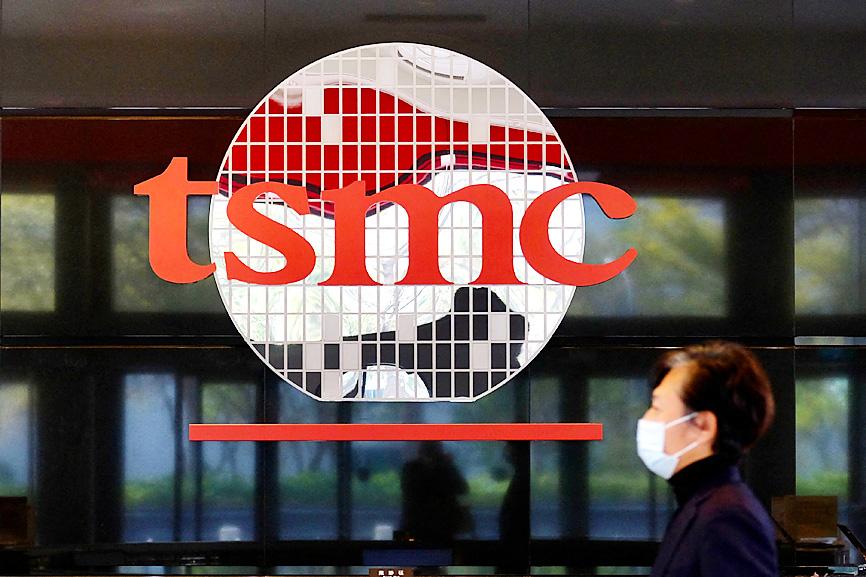Taiwan Semiconductor Manufacturing Co (TSMC, 台積電) is expected to post a 25 percent year-on-year increase in sales in the first quarter of this year to US$12.91 billion, up from US$10.31 billion a year earlier, as its production is at full capacity, market advisory firm TrendForce Corp said in a note last week.
The increase would help TSMC cement its leadership in the industry by taking a 56 percent market share in the global pure wafer foundry business, TrendForce said.
Its forecast was in line with TSMC’s estimate in January, which pointed to a range of US$12.7 billion to US$13 billion for the first quarter.

Photo: Sam Yeh, AFP
TSMC is to benefit from its efforts to develop a 5-nanometer production process, which began mass production in the second quarter of last year, TrendForce said.
The process is expected to account for about 20 percent of TSMC’s total revenue in the first quarter, it added.
TSMC is expected to continue to see solid demand for its 7-nanometer technology from major customers, such as US-based Advanced Micro Devices Inc, Nvidia Corp and Qualcomm Inc, as well as Taiwan’s MediaTek Inc (聯發科), TrendForce said.
The 7-nanometer process is expected to make up more than 30 percent of TSMC’s total sales in the first quarter, the advisory firm said.
TSMC is expected to receive an additional boost from strong global demand for 5G applications, high-performance computing devices and automotive electronics, it added.
Smaller local rival United Microelectronics Corp (UMC, 聯電) is expected to see its sales for the first quarter rise 14 percent from a year earlier to US$1.60 billion, giving it a 7 percent market share and placing it third globally, TrendForce said.
UMC is expected to receive large orders in a wide range of products, such as driver ICs, power management ICs, radio-frequency applications and the Internet of Things, in the first quarter, it said.
South Korea’s Samsung Electronics Co is expected to follow TSMC in sales, generating US$4.05 billion, up 11 percent from a year earlier, to take an 18 percent share in the global market, TrendForce said.
US-based GlobalFoundries Inc is expected to take the fourth position, generating US$1.47 billion in sales in the first quarter, followed by China’s Semiconductor Manufacturing International Corp (中芯國際, US$1.06 billion), Israel’s Tower Semiconductor Ltd (US$345 million), Taiwan’s Powerchip Semiconductor Manufacturing Corp (力積電, US$340 million) and Vanguard International Semiconductor Corp (世界先進, US$327 million), China’s Hua Hong Semiconductor Ltd (華虹半導體, US$288 million) and South Korea’s DB HiTek Co (US$197 million).

MULTIFACETED: A task force has analyzed possible scenarios and created responses to assist domestic industries in dealing with US tariffs, the economics minister said The Executive Yuan is tomorrow to announce countermeasures to US President Donald Trump’s planned reciprocal tariffs, although the details of the plan would not be made public until Monday next week, Minister of Economic Affairs J.W. Kuo (郭智輝) said yesterday. The Cabinet established an economic and trade task force in November last year to deal with US trade and tariff related issues, Kuo told reporters outside the legislature in Taipei. The task force has been analyzing and evaluating all kinds of scenarios to identify suitable responses and determine how best to assist domestic industries in managing the effects of Trump’s tariffs, he

TIGHT-LIPPED: UMC said it had no merger plans at the moment, after Nikkei Asia reported that the firm and GlobalFoundries were considering restarting merger talks United Microelectronics Corp (UMC, 聯電), the world’s No. 4 contract chipmaker, yesterday launched a new US$5 billion 12-inch chip factory in Singapore as part of its latest effort to diversify its manufacturing footprint amid growing geopolitical risks. The new factory, adjacent to UMC’s existing Singapore fab in the Pasir Res Wafer Fab Park, is scheduled to enter volume production next year, utilizing mature 22-nanometer and 28-nanometer process technologies, UMC said in a statement. The company plans to invest US$5 billion during the first phase of the new fab, which would have an installed capacity of 30,000 12-inch wafers per month, it said. The

Taiwan’s official purchasing managers’ index (PMI) last month rose 0.2 percentage points to 54.2, in a second consecutive month of expansion, thanks to front-loading demand intended to avoid potential US tariff hikes, the Chung-Hua Institution for Economic Research (CIER, 中華經濟研究院) said yesterday. While short-term demand appeared robust, uncertainties rose due to US President Donald Trump’s unpredictable trade policy, CIER president Lien Hsien-ming (連賢明) told a news conference in Taipei. Taiwan’s economy this year would be characterized by high-level fluctuations and the volatility would be wilder than most expect, Lien said Demand for electronics, particularly semiconductors, continues to benefit from US technology giants’ effort

‘SWASTICAR’: Tesla CEO Elon Musk’s close association with Donald Trump has prompted opponents to brand him a ‘Nazi’ and resulted in a dramatic drop in sales Demonstrators descended on Tesla Inc dealerships across the US, and in Europe and Canada on Saturday to protest company chief Elon Musk, who has amassed extraordinary power as a top adviser to US President Donald Trump. Waving signs with messages such as “Musk is stealing our money” and “Reclaim our country,” the protests largely took place peacefully following fiery episodes of vandalism on Tesla vehicles, dealerships and other facilities in recent weeks that US officials have denounced as terrorism. Hundreds rallied on Saturday outside the Tesla dealership in Manhattan. Some blasted Musk, the world’s richest man, while others demanded the shuttering of his